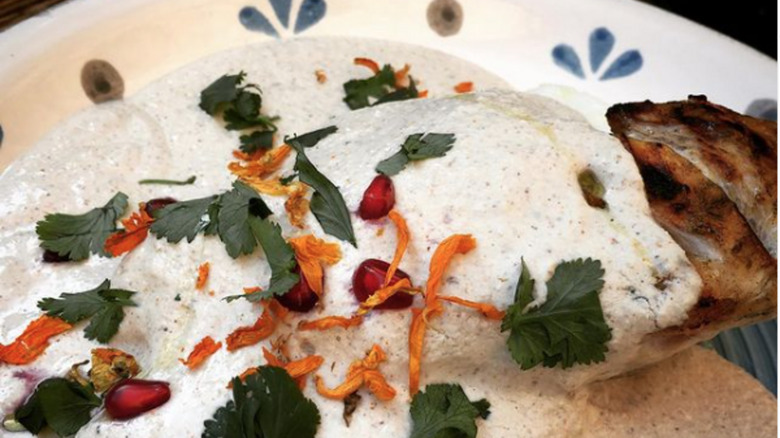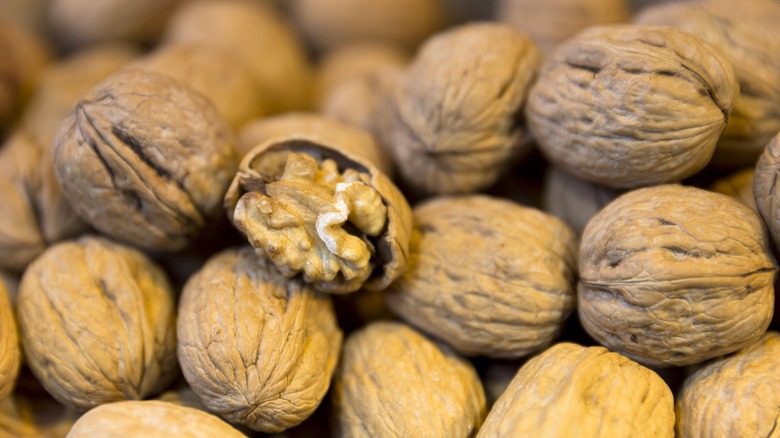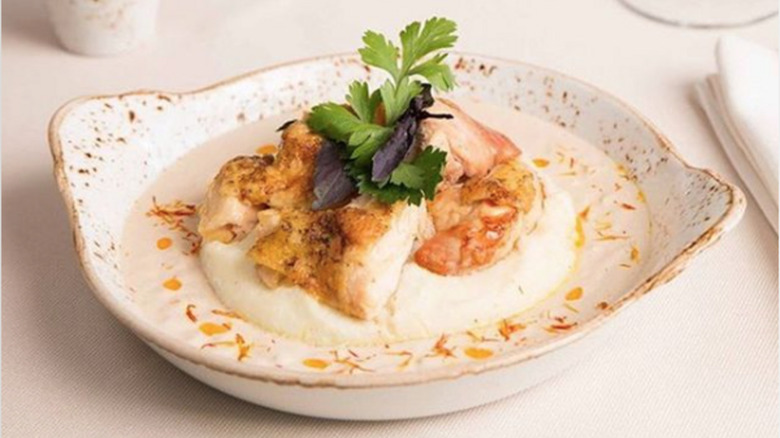Bazhe Is The Nutty And Garlic Georgian Sauce You Should Know About
The state of Georgia may be the home of many wonderful Southern American dishes, but the country of Georgia can also boast of its diverse and comforting cuisine. Exhibit A is bazhe, a versatile sauce made with walnuts, garlic, and spices. History shows that walnut trees have been growing in Georgia possibly as far back as the sixth century B.C. and are considered sacred in the Caucasus, so it's no surprise that the nut is well-represented in regional cooking. All in all, mastering bazhe will extend your walnut-cooking repertoire.
Bazhe is derived from Satsivi, a Georgian dish consisting of chicken or turkey made with a walnut sauce and served cold. Satsivi is also made with walnuts and garlic as well as exotic herbs and spices like ground fenugreek seed, saffron, and dried marigold powder (also known as calendula). A souring agent like vinegar is used in Satsivi but is more pronounced in bazhe, making it a little thinner and saucier than its parent recipe. Bazhe is most often served during Georgian supras, or feasts, which take place around end-of-year holidays, particularly New Year's Eve.
Ingredients in bazhe
Once you have the right ingredients, bazhe is easy to make. Combine ground walnuts, minced garlic, salt, ground fenugreek and coriander seeds, cayenne pepper, dried marigold, and red or white wine vinegar (or pomegranate juice) in a medium bowl. Stir in water until your bazhe sauce achieves the desired thickness. Add a few drops of walnut oil if you'd like as a finishing touch. Properly stored, bazhe will keep in the refrigerator for up to four days.
Of course, walnut pieces, garlic, vinegars, and many of the above-mentioned spices are widely available in domestic grocery stores, while whole and ground fenugreek seed can be obtained in any Indian food market. Don't skip this ingredient if you can help it — fenugreek seeds have a sweet, vaguely bitter maple taste. Calendula, which resembles saffron and has a peppery citrus flavor with a hint of anise, is easy to order online. Together, these ingredients give this simple sauce a profound depth.
How to cook with bazhe
Georgians, who can't seem to get enough of the stuff, use bazhe on chicken, fried fish, boiled eggs, and ghomi — a traditional corn flour porridge topped with cheese. Bazhe is so good it's even smeared on top of a slice of bread for a quick snack. If you'd like to start with a traditional main course, chicken bazhe will serve as a great introduction. In it, chicken is marinated in puréed tomatoes, garlic, bay leaves, salt, and sugar for several hours, baked, covered in bazhe, and heated through.
Once you have the hang of making it, try bazhe on whatever suits your fancy. In addition to fried or boiled poultry and fish, it pairs well with all manner of potato dishes (French fry dip, anyone?), noodles, and eggplant recipes. It will shine as a main course or be an inspired last-minute spaghetti sauce. You can tailor the thickness of your bazhe to whatever application you have in mind — main course dishes with chicken and eggplant require a thicker bazhe than a dipping sauce. Whisking in a little water to thin out a thick sauce will neatly do the trick if needed.


